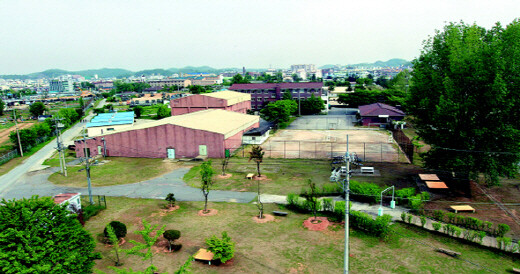hankyoreh
Links to other country sites 다른 나라 사이트 링크
New allegations emerge of USFK chemical dumping

By Kwon Tae-ho, Washington Correspondent
A retired U.S. military officer testified to the burial of large quantities of chemicals at a U.S. military base in Bucheon, Gyeonggi Province, it was belatedly revealed Monday. This revelation comes just after an eyewitness account stating that Agent Orange was buried at Camp Carroll in Chilgok, North Gyeongsang Province. While there was no way of confirming whether the chemicals in the latest account included defoliants, controversy is expected following the revelation of another instance of the USFK disposing of chemicals by burying them in the ground.
Korean-American Chi Yong An posted the account by a retired U.S. military officer on his web page Secret of Korea on Monday (local time). The author of the piece, which An titled “I buried hundreds of gallons of chemicals at Camp Mercer in Bucheon’s Ojeong neighborhood,” was Ray Bows, who said he worked at Camp Mercer between July 1963 and April 1964 as a member of the 547th Engineer Company, 44th Engineer Construction Battalion, U.S. Army Corps of Engineers.
In the piece, which was originally posted in May 2004 on the website of the Korean War Veterans Association, Bows wrote, “We dug a pit with a bulldozer - doned rubber suits and gas masks and dump every imaginable chemical - hundreds of gallons if not more - into the ground.”
Bows also gave specifics about the location of the burial, which he described as “a knoll behind the second storage warehouse on the right” from the main entrance.
The U.S. returned Camp Mercer to South Korea in the early 1990s. The site, which measures 429,000 square meters, is current being used as a South Korean military camp.
Bows stated that the U.S. Army Chemical Depot Korea was located at Camp Mercer at the time and was moved the Camp Carroll, the suspected Agent Orange burial site, between March and April of 1964. He also reported hearing that the reason for the relocation was that the chemical depot was “too close” to the Demilitarized Zone.
Secret of Korea also posted a list of large quantities of waste materials disposed of between 1987 and 1989 by the USFK Defense Reutilization and Marketing Office (DRMO) at Camp Market in Incheon’s Bupyeong district, as ascertained through a 1991 document commissioned and published by the US Army Corps of Engineers Construction Engineering Research Laboratory. According to the document, more than 500 drums of materials such as mercury, spent batteries, outdated medications, solvent waste, asbestos, sodium sulfate solution, and waste oil were disposed of in 1987 alone.
Meanwhile, the U.S. government visited the house of former USFK soldier Steve House, 54, for more than four hours of questioning Monday. House previously testified to the burial of Agent Orange at Camp Carroll. The questioning Monday was reportedly conducted by three U.S. military officers, including a public information official, military waste treatment expert, and USFK official, with House’s attorney in attendance.
Following the questioning, House called the meeting “productive” and said his understanding was that the contents would be reported to Seoul and Washington.
Please direct questions or comments to [englishhani@hani.co.kr]
Editorial・opinion
![[Correspondent’s column] China-Europe relations tested once more by EV war [Correspondent’s column] China-Europe relations tested once more by EV war](https://flexible.img.hani.co.kr/flexible/normal/500/300/imgdb/original/2024/0628/7617195640940814.jpg) [Correspondent’s column] China-Europe relations tested once more by EV war
[Correspondent’s column] China-Europe relations tested once more by EV war![[Correspondent’s column] Who really created the new ‘axis of evil’? [Correspondent’s column] Who really created the new ‘axis of evil’?](https://flexible.img.hani.co.kr/flexible/normal/500/300/imgdb/original/2024/0628/4017195633070654.jpg) [Correspondent’s column] Who really created the new ‘axis of evil’?
[Correspondent’s column] Who really created the new ‘axis of evil’?- [Editorial] Exploiting foreign domestic workers won’t solve Korea’s birth rate problem
- [Column] Kim and Putin’s new world order
- [Editorial] Workplace hazards can be prevented — why weren’t they this time?
- [Editorial] Seoul failed to use diplomacy with Moscow — now it’s resorting to threats
- [Column] Balloons, drones, wiretapping… Yongsan’s got it all!
- [Editorial] It’s time for us all to rethink our approach to North Korea
- [Column] Why empty gestures matter more than ever
- [Editorial] Seoul’s part in N. Korea, Russia upgrading ties to a ‘strategic partnership’
Most viewed articles
- 1Dreams of a better life brought them to Korea — then a tragic fire tore them apart
- 2[Correspondent’s column] China-Europe relations tested once more by EV war
- 3CIA record confirms US ‘completely destroyed’ Seoul’s Haebangchon in 1950 bombardment
- 4Yoon echoed conspiracy theories about Itaewon disaster, former National Assembly speaker says
- 5[Correspondent’s column] Who really created the new ‘axis of evil’?
- 6After 7 years, South Korea resumes live-fire drills on islands a stone’s throw from North
- 7S. Korea joins US, Japan for first multi-domain drills at a time of escalating tensions
- 8Nuclear South Korea back up for debate as North cozies up to Russia
- 9Dispatched into unknown danger, foreign day laborers were defenseless against blaze
- 10‘Disposable’: How illegal temp work practices push migrants in Korea into risky jobs